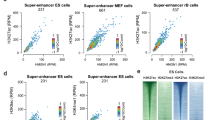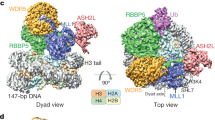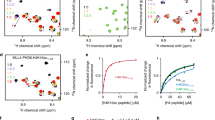Abstract
Although histone H3 Lys4 (H3K4) methylation is widely associated with gene activation, direct evidence for its causal role in transcription, through specific MLL family members, is scarce. Here we have purified a human MLL2 (Kmt2b) complex that is highly active in H3K4 methylation and chromatin transcription in a cell-free system. This effect requires S-adenosyl methionine and intact H3K4, thus establishing a direct and causal role for MLL2-mediated H3K4 methylation in transcription. We also show that human AKAP95, a chromatin-associated protein, physically and functionally associates with MLL complexes and directly enhances their methyltransferase activity. Ectopic AKAP95 stimulates expression of a chromosomal reporter gene in synergy with MLL1 or MLL2, whereas AKAP95 depletion impairs retinoic acid–mediated gene induction in embryonic stem cells. These results demonstrate an important role for AKAP95 in regulating histone methylation and gene expression, particularly during cell-fate transitions.
This is a preview of subscription content, access via your institution
Access options
Subscribe to this journal
Receive 12 print issues and online access
$189.00 per year
only $15.75 per issue
Buy this article
- Purchase on Springer Link
- Instant access to full article PDF
Prices may be subject to local taxes which are calculated during checkout







Similar content being viewed by others
Accession codes
References
Kouzarides, T. Chromatin modifications and their function. Cell 128, 693–705 (2007).
Li, B., Carey, M. & Workman, J.L. The role of chromatin during transcription. Cell 128, 707–719 (2007).
Shahbazian, M.D. & Grunstein, M. Functions of site-specific histone acetylation and deacetylation. Annu. Rev. Biochem. 76, 75–100 (2007).
Shilatifard, A. Molecular implementation and physiological roles for histone H3 lysine 4 (H3K4) methylation. Curr. Opin. Cell Biol. 20, 341–348 (2008).
Ruthenburg, A.J., Allis, C.D. & Wysocka, J. Methylation of lysine 4 on histone H3: intricacy of writing and reading a single epigenetic mark. Mol. Cell 25, 15–30 (2007).
Shilatifard, A. The COMPASS family of histone H3K4 methylases: mechanisms of regulation in development and disease pathogenesis. Annu. Rev. Biochem. 81, 65–95 (2012).
Santos-Rosa, H. et al. Active genes are tri-methylated at K4 of histone H3. Nature 419, 407–411 (2002).
Schneider, R. et al. Histone H3 lysine 4 methylation patterns in higher eukaryotic genes. Nat. Cell Biol. 6, 73–77 (2004).
Bernstein, B.E. et al. Methylation of histone H3 Lys 4 in coding regions of active genes. Proc. Natl. Acad. Sci. USA 99, 8695–8700 (2002).
Barski, A. et al. High-resolution profiling of histone methylations in the human genome. Cell 129, 823–837 (2007).
Dou, Y. et al. Regulation of MLL1 H3K4 methyltransferase activity by its core components. Nat. Struct. Mol. Biol. 13, 713–719 (2006).
Dou, Y. et al. Physical association and coordinate function of the H3 K4 methyltransferase MLL1 and the H4 K16 acetyltransferase MOF. Cell 121, 873–885 (2005).
Hughes, C.M. et al. Menin associates with a trithorax family histone methyltransferase complex and with the hoxc8 locus. Mol. Cell 13, 587–597 (2004).
Milne, T.A. et al. MLL targets SET domain methyltransferase activity to Hox gene promoters. Mol. Cell 10, 1107–1117 (2002).
Wysocka, J. et al. WDR5 associates with histone H3 methylated at K4 and is essential for H3 K4 methylation and vertebrate development. Cell 121, 859–872 (2005).
Demers, C. et al. Activator-mediated recruitment of the MLL2 methyltransferase complex to the β-globin locus. Mol. Cell 27, 573–584 (2007).
Vermeulen, M. et al. Quantitative interaction proteomics and genome-wide profiling of epigenetic histone marks and their readers. Cell 142, 967–980 (2010).
Vermeulen, M. & Timmers, H.T. Grasping trimethylation of histone H3 at lysine 4. Epigenomics 2, 395–406 (2010).
Lim, D.A. et al. Chromatin remodelling factor Mll1 is essential for neurogenesis from postnatal neural stem cells. Nature 458, 529–533 (2009).
Rathert, P., Dhayalan, A., Ma, H. & Jeltsch, A. Specificity of protein lysine methyltransferases and methods for detection of lysine methylation of non-histone proteins. Mol. Biosyst. 4, 1186–1190 (2008).
Zhang, K. et al. The Set1 methyltransferase opposes Ipl1 aurora kinase functions in chromosome segregation. Cell 122, 723–734 (2005).
Cho, Y.W. et al. PTIP associates with MLL3- and MLL4-containing histone H3 lysine 4 methyltransferase complex. J. Biol. Chem. 282, 20395–20406 (2007).
Jiang, H. et al. Role for Dpy-30 in ES cell-fate specification by regulation of H3K4 methylation within bivalent domains. Cell 144, 513–525 (2011).
Wong, W. & Scott, J.D. AKAP signalling complexes: focal points in space and time. Nat. Rev. Mol. Cell Biol. 5, 959–970 (2004).
Jungmann, R.A. & Kiryukhina, O. Cyclic AMP and AKAP-mediated targeting of protein kinase A regulates lactate dehydrogenase subunit A mRNA stability. J. Biol. Chem. 280, 25170–25177 (2005).
Eide, T. et al. Protein kinase A-anchoring protein AKAP95 interacts with MCM2, a regulator of DNA replication. J. Biol. Chem. 278, 26750–26756 (2003).
Li, Y. et al. A novel histone deacetylase pathway regulates mitosis by modulating Aurora B kinase activity. Genes Dev. 20, 2566–2579 (2006).
Collas, P., Le Guellec, K. & Tasken, K. The A-kinase-anchoring protein AKAP95 is a multivalent protein with a key role in chromatin condensation at mitosis. J. Cell Biol. 147, 1167–1180 (1999).
Bomar, J., Moreira, P., Balise, J.J. & Collas, P. Differential regulation of maternal and paternal chromosome condensation in mitotic zygotes. J. Cell Sci. 115, 2931–2940 (2002).
Akileswaran, L., Taraska, J.W., Sayer, J.A., Gettemy, J.M. & Coghlan, V.M. A-kinase-anchoring protein AKAP95 is targeted to the nuclear matrix and associates with p68 RNA helicase. J. Biol. Chem. 276, 17448–17454 (2001).
van den Berg, D.L. et al. An Oct4-centered protein interaction network in embryonic stem cells. Cell Stem Cell 6, 369–381 (2010).
An, W. & Roeder, R.G. Reconstitution and transcriptional analysis of chromatin in vitro. Methods Enzymol. 377, 460–474 (2004).
An, W., Kim, J. & Roeder, R.G. Ordered cooperative functions of PRMT1, p300, and CARM1 in transcriptional activation by p53. Cell 117, 735–748 (2004).
An, W., Palhan, V.B., Karymov, M.A., Leuba, S.H. & Roeder, R.G. Selective requirements for histone H3 and H4 N termini in p300-dependent transcriptional activation from chromatin. Mol. Cell 9, 811–821 (2002).
Tsukiyama, T. & Wu, C. Purification and properties of an ATP-dependent nucleosome remodeling factor. Cell 83, 1011–1020 (1995).
Carr, D.W., Hausken, Z.E., Fraser, I.D., Stofko-Hahn, R.E. & Scott, J.D. Association of the type II cAMP-dependent protein kinase with a human thyroid RII-anchoring protein: cloning and characterization of the RII-binding domain. J. Biol. Chem. 267, 13376–13382 (1992).
Eide, T. et al. Distinct but overlapping domains of AKAP95 are implicated in chromosome condensation and condensin targeting. EMBO Rep. 3, 426–432 (2002).
Goo, Y.H. et al. Activating signal cointegrator 2 belongs to a novel steady-state complex that contains a subset of trithorax group proteins. Mol. Cell Biol. 23, 140–149 (2003).
Pavri, R. et al. Histone H2B monoubiquitination functions cooperatively with FACT to regulate elongation by RNA polymerase II. Cell 125, 703–717 (2006).
Lin, J.J. et al. Mediator coordinates PIC assembly with recruitment of CHD1. Genes Dev. 25, 2198–2209 (2011).
Lauberth, S.M. et al. H3K4me3 interactions with TAF3 regulate preinitiation complex assembly and selective gene activation. Cell 152, 1021–1036 (2013).
Tang, Z. et al. SET1 and p300 act synergistically, through coupled histone modifications, in transcriptional activation by p53. Cell 154, 297–310 (2013).
Beene, D.L. & Scott, J.D. A-kinase anchoring proteins take shape. Curr. Opin. Cell Biol. 19, 192–198 (2007).
Dignam, J.D., Lebovitz, R.M. & Roeder, R.G. Accurate transcription initiation by RNA polymerase II in a soluble extract from isolated mammalian nuclei. Nucleic Acids Res. 11, 1475–1489 (1983).
Guermah, M., Kim, J. & Roeder, R.G. Transcription of in vitro assembled chromatin templates in a highly purified RNA polymerase II system. Methods 48, 353–360 (2009).
Nelson, J.D., Denisenko, O. & Bomsztyk, K. Protocol for the fast chromatin immunoprecipitation (ChIP) method. Nat. Protoc. 1, 179–185 (2006).
Livak, K.J. & Schmittgen, T.D. Analysis of relative gene expression data using real-time quantitative PCR and the 2−ΔΔCT method. Methods 25, 402–408 (2001).
Zhang, J., Kalkum, M., Chait, B.T. & Roeder, R.G. The N-CoR-HDAC3 nuclear receptor corepressor complex inhibits the JNK pathway through the integral subunit GPS2. Mol. Cell 9, 611–623 (2002).
Acknowledgements
We thank Kazusa DNA Research Institute (Japan) for providing the cDNA KIAA0304. We thank J. Kim (Rockefeller University (RU)) for histone H3 and H4 with mutations in acetylation sites, E. McIntush (Bethyl Laboratories) and C. Hughes (RU) for the antibody to DPY30, Q. Yang (RU) for multiple valuable reagents, J. Wysocka (Stanford University) for the antibody to WDR5, A. Goldberg and D. Allis (RU) for LIF and Z. Fu and Z. Yan (RU) for excellent technical assistance. H.J. was supported by a fellowship from the Leukemia and Lymphoma Society, and X.L. was supported as a recipient of the C.H. Li Memorial Scholar Award. This work was supported by grants from the US National Institutes of Health (CA129325 and DK071900) and the Ellison Medical Foundation (AG-SS-2665-11) to R.G.R. and by a Leukemia and Lymphoma Society SCOR grant (7132-08).
Author information
Authors and Affiliations
Contributions
H.J. and X.L. conceived of the project, designed and performed the experiments, analyzed the data and wrote the paper. M.S. and Y.D. performed experiments. Z.T. generated the K4Q mutant octamer. R.G.R. conceived of the project, analyzed the data, wrote the paper, supervised the project and had overall responsibility for the joint research.
Corresponding author
Ethics declarations
Competing interests
The authors declare no competing financial interests.
Supplementary information
Supplementary Text and Figures
Supplementary Figures 1–8 and Supplementary Tables 1 and 2 (PDF 1580 kb)
Rights and permissions
About this article
Cite this article
Jiang, H., Lu, X., Shimada, M. et al. Regulation of transcription by the MLL2 complex and MLL complex–associated AKAP95. Nat Struct Mol Biol 20, 1156–1163 (2013). https://doi.org/10.1038/nsmb.2656
Received:
Accepted:
Published:
Issue Date:
DOI: https://doi.org/10.1038/nsmb.2656
This article is cited by
-
High AKAP8L expression predicts poor prognosis in esophageal squamous cell carcinoma
Cancer Cell International (2022)
-
Phase separation drives tumor pathogenesis and evolution: all roads lead to Rome
Oncogene (2022)
-
Oncogenic splicing regulated by phase separation
Nature Cell Biology (2020)
-
Biophysical properties of AKAP95 protein condensates regulate splicing and tumorigenesis
Nature Cell Biology (2020)
-
Why are so many MLL lysine methyltransferases required for normal mammalian development?
Cellular and Molecular Life Sciences (2019)



